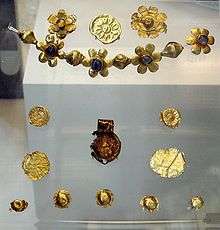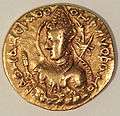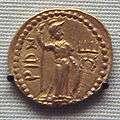Huvishka
| Huvishka | |
|---|---|
| Kushan emperor | |
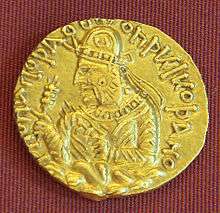 Coin of Huvishka. Legend in Kushan language and Greek script (with the Kushan letter Ϸ "sh"): ϷΑΟΝΑΝΟϷΑΟ ΟΟΗϷΚΙ ΚΟϷΑΝΟ ("Shaonanoshao Ooishki Koshano"): "King of kings, Huvishka the Kushan". | |
| Reign | 140–180 CE |
| Predecessor | Kanishka |
| Successor | Vasudeva I |
| Burial | Peshawar, Pakistan |
| Dynasty | Kushan |
Huvishka (Kushan: Οοηϸκι, "Ooishki") was the emperor of the Kushan Empire from the death of Kanishka (assumed on the best evidence available to be in 140 CE) until the succession of Vasudeva I about forty years later. His rule was a period of retrenchment and consolidation for the Empire.
Religion
Huvishka was the son of Kanishka. His reign is also known as the golden age of Kushan rule. The reign of Huvishka corresponds to the first known epigraphic evidence of the Buddha Amitabha, on the bottom part of a 2nd-century statue which has been found in Govindo-Nagar, and now at the Mathura Museum. The statue is dated to "the 28th year of the reign of Huvishka", and dedicated to "Amitabha Buddha" by a family of merchants. There is also some evidence that Huvishka himself was a follower of Mahāyāna Buddhism. A Sanskrit manuscript fragment in the Schøyen Collection describes Huvishka as one who has "set forth in the Mahāyāna."[1]
Compared to his predecessor Kanishka, Huvishka was worshipper of Shiva.
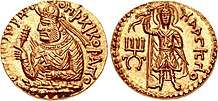
He also incorporates in his coins for the first and unique time in Kushan coinage the Hellenistic-Egyptian Serapis (under the name Σαραπο, "Sarapo"[2]), and the Goddess Roma (thought to represent "Roma aeterna"), under the name "Riom" (Greek: ΡΙΟΜ).[3]
Some of the coins of Huvishka also featured Maaseno on his coins, the Kushan incarnation of the Hindu god Karttikeya, or Skanda, whose epithet was "Mahasena". This god being particularly important to the Yaudheyas, it may have been incorporated into Kushan coinage when the Kushans expanded into Yaudheya territory in order to establish control of the Mathura area. It may also have been adopted as a way to appease the warlike Yaudheyas. In effect, the Kushans became the suzerains of the Yaudheyas in the area.[4][5][5]
Coinage
One of the great remaining puzzles of Huvishka's reign is the devaluation of his coinage. Early in his reign the copper coinage plunged in weight from a standard of 16g to about 10-11g. The quality and weight then continued to decline throughout the reign until at the start of the reign of Vasudeva the standard coin (a tetradrachm) weighed only 9g. The devaluation led to a massive production of imitations, and an economic demand for the older, pre-devaluation coins in the Gangetic valley. However, the motivation (and even some of the details) of this devaluation are still unknown.
|
|
Notes
| Wikimedia Commons has media related to Huvishka. |
- ↑ Neelis, Jason. Early Buddhist Transmission and Trade Networks. 2010. p. 141
- ↑ Serapis coin
- ↑ Mario Bussagli, "L'Art du Gandhara", 225
- ↑ Classical Numismatics Group
- 1 2 Indian Sculpture: Circa 500 B.C.-A.D. 700, Los Angeles County Museum of Art, Pratapaditya Pal, University of California Press, 1986, p.78
External links
- Online Catalogue of Huvishka's Coinage
- Coins of Huvishka
- Was Huvishka sole king of the Kushan Empire
- The Devaluation of the Coinage of Kanishka
| Preceded by Kanishka |
Kushan Ruler 140–183 CE |
Succeeded by Vasudeva I |
| Kushan Empire Emperors, territories and chronology | ||||||||||||
| Territories/ dates | Western India | Western Pakistan Balochistan | Paropamisadae Arachosia | Bajaur | Gandhara | Western Punjab | Eastern Punjab | Mathura | Pataliputra | |||
|---|---|---|---|---|---|---|---|---|---|---|---|---|
| INDO-SCYTHIAN KINGDOM | INDO-GREEK KINGDOM | Indo-Scythian Northern Satraps | ||||||||||
| 25 BCE – 10 CE | Indo-Scythian dynasty of the APRACHARAJAS Vijayamitra (ruled 12 BCE - 15 CE)[1] |
Liaka Kusulaka Patika Kusulaka Zeionises |
Kharahostes (ruled 10 BCE– 10 CE)[2] Mujatria |
Strato II and Strato III | Hagana | |||||||
| 10-20CE | INDO-PARTHIAN KINGDOM Gondophares |
Indravasu | INDO-PARTHIAN KINGDOM Gondophares |
Rajuvula | ||||||||
| 20-30 CE | Ubouzanes Pakores |
Vispavarma (ruled c.0-20 CE)[3] |
Sarpedones | Bhadayasa | Sodasa | |||||||
| 30-40 CE | KUSHAN EMPIRE Kujula Kadphises |
Indravarma | Abdagases | ... | ... | |||||||
| 40-45 CE | Aspavarma | Gadana | ... | ... | ||||||||
| 45-50 CE | Sasan | Sases | ... | ... | ||||||||
| 50-75 CE | ... | ... | ||||||||||
| 75-100 CE | Indo-Scythian dynasty of the WESTERN SATRAPS Chastana |
Vima Takto | ... | ... | ||||||||
| 100-120 CE | Abhiraka | Vima Kadphises | ... | ... | ||||||||
| 120 CE | Bhumaka Nahapana |
PARATARAJAS Yolamira |
Kanishka I | Great Satrap Kharapallana and Satrap Vanaspara for Kanishka I | ||||||||
| 130-230 CE |
Jayadaman |
Bagamira |
Vāsishka (c. 140 – c. 160) | |||||||||
| 230-280 CE |
Samghadaman |
Miratakhma |
INDO-SASANIANS |
Kanishka II (c. 230 – 240) |
||||||||
| 280-300 | Bhratadarman | Datayola II |
Hormizd II, "Kushanshah" (c. 295 – 300) |
Vasudeva II (c. 275 – 310) | ||||||||
| 300-320 CE |
Visvasena |
Peroz II, "Kushanshah" (c. 300 – 325) |
Vasudeva III |
|||||||||
| 320-388 CE |
Yasodaman II |
Shapur II Sassanid king and "Kushanshah" (c. 325) |
||||||||||
| 388-396 CE | Rudrasimha III | Chandragupta II | ||||||||||
- ↑ From the dated inscription on the Rukhana reliquary
- ↑ An Inscribed Silver Buddhist Reliquary of the Time of King Kharaosta and Prince Indravarman, Richard Salomon, Journal of the American Oriental Society, Vol. 116, No. 3 (Jul. - Sep., 1996), pp. 442
- ↑ A Kharosthī Reliquary Inscription of the Time of the Apraca Prince Visnuvarma, by Richard Salomon, South Asian Studies 11 1995, Pages 27-32, Published online: 09 Aug 2010

